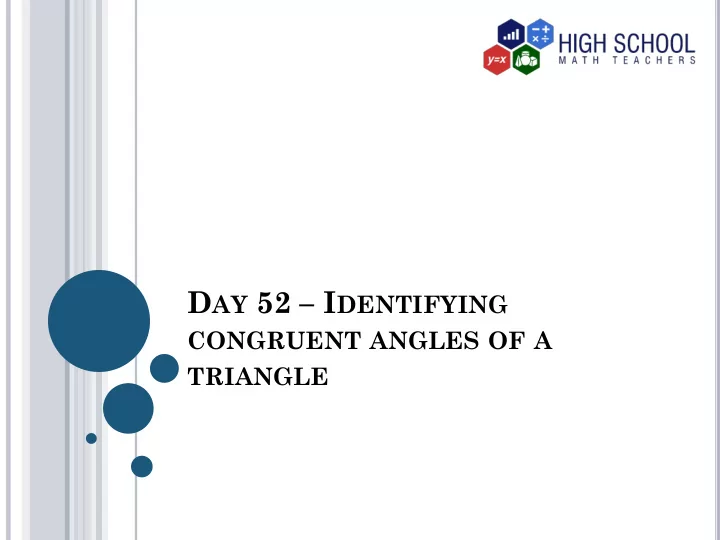

D AY 52 – I DENTIFYING CONGRUENT ANGLES OF A TRIANGLE
I NTRODUCTION The fundamental property of rigid transformations of the plane is that they preserve both the size and shape of a given plane figure. If two plane figures are congruent, they will have corresponding parts, and these parts will be congruent. In our previous lessons on rigid motion, we should have discovered that when two figures are congruent, there is always a rigid motion that maps one figure to the other. In this lesson, we are going to learn how to identify congruent angles in triangles based on rigid motion.
V OCABULARY 1. Congruent Angles Angles that have the same measure. 2. Orientation The arrangement of vertices of a plane figure in relation to one another after a transformation. 3. Corresponding angles in congruent triangles Angles in the same position relative to the angles in the other congruent triangle.
Our main aim is to identify congruent angles between a triangle and its image after undergoing all the rigid motions, based on the fact that corresponding angles in congruent triangles are equal. When identifying congruent angles in congruent triangles, we match angles of one triangle to the angles of the other triangle, that is, we identify pairs of corresponding angles.
I DENTIFYING CONGRUENT ANGLES IN TRIANGLES AFTER A TRANSLATION In the figure below ΔABC has been mapped onto ΔPQR after a translation. A C P R B Q
Since a translation is a rigid motion, it means that ΔABC ≅ ΔPQR . The corresponding angles will be congruent. Orientation is preserved in a translation. Therefore, it is easy to identify corresponding parts. Let us first identify the mapping of corresponding vertices from the triangles as indicated below. 𝐁 → 𝐐 𝐂 → 𝐑 𝐃 → 𝐒 Then the mapping of corresponding sides becomes: AB → PQ ; BC → QR ; AC → PR
We can now easily identify how the corresponding angles are mapped as shown below. ∠𝐁 → ∠𝐐 ∠𝐂 → ∠𝐑 ∠𝐃 → ∠𝐒 This corresponding angles are congruent. At this stage we can easily identify pairs of congruent angles. These pairs are: ∠𝐁 ≅ ∠𝐐 ∠𝐂 ≅ ∠𝐑 ∠𝐃 ≅ ∠𝐒
I DENTIFYING CONGRUENT ANGLES IN TRIANGLES AFTER A REFLECTION In the figure below ΔABC has been mapped onto ΔPQR after a reflection along the mirror line 𝑚 . A P C Q R B 𝑚
A reflection is a rigid motion. Consequently, it is clear that ΔABC ≅ ΔPQR . The corresponding angles will therefore be congruent. Orientation is not preserved in a reflection. Therefore, we should note that the vertices are reversed in the image. The distance of vertices from the mirror line remains the same after reflection. This implies that vertices near the mirror line will also be near the mirror line after reflection and vertices further away from the mirror line will also be further away after reflection. Basing on these ideas, the mapping of corresponding vertices becomes: 𝐁 → 𝐐, 𝐂 → 𝐒, 𝐃 → Q
The mapping of corresponding sides becomes: AB → PR ; BC → RQ ; AC → PQ We can now easily identify the mapping of corresponding angles as: ∠𝐁 → ∠𝐐, ∠𝐂 → ∠𝐒, ∠𝐃 → ∠𝐑 This corresponding angles are congruent. The pairs of congruent angles in the triangles after the reflection become: ∠𝐁 ≅ ∠𝐐, ∠𝐂 ≅ ∠𝐒, ∠𝐃 ≅ ∠𝐑
I DENTIFYING CONGRUENT ANGLES IN TRIANGLES AFTER A ROTATION In the grid below ΔABC has been mapped onto ΔPQR after a rotation of −90° about point. A P R Q B C
A rotation is also rigid motion. Consequently, it is clear that ΔABC ≅ ΔPQR . The corresponding angles will be congruent. Orientation is preserved under a rotation; vertices remain in the same order. The mapping of corresponding vertices becomes: 𝐁 → 𝐒, 𝐂 → 𝐐, 𝐃 → Q The mapping of corresponding sides becomes: AB → RP ; BC → PQ ; AC → RQ We can now easily identify the mapping of corresponding angles as: ∠𝐁 → ∠𝐒, ∠𝐂 → ∠𝐐, ∠𝐃 → ∠𝐑
This corresponding angles are congruent. The pairs of congruent angles in triangles after the rotation become. ∠𝐁 ≅ ∠𝐒, ∠𝐂 ≅ ∠𝐐, ∠𝐃 ≅ ∠𝐑
I DENTIFYING CONGRUENT ANGLES IN TRIANGLES AFTER A GLIDE REFLECTION In the figure below ΔABC has been mapped onto ΔPQR after a glide reflection. A C B 𝑛 R Q P
A glide reflection is also rigid motion. Consequently, it is clear that ΔABC ≅ ΔPQR . The corresponding angles will be congruent. Orientation is reversed under a reflection but preserved under translation. The mapping of corresponding vertices becomes: 𝐁 → 𝐐, 𝐂 → 𝐒, 𝐃 → Q The mapping of corresponding sides becomes: AB → PR ; BC → RQ ; AC → PQ We can now easily identify the mapping of corresponding angles as: ∠𝐁 → ∠𝐐, ∠𝐂 → ∠𝐒, ∠𝐃 → ∠𝐑
This corresponding angles are congruent to each other. The pairs of congruent angles become: ∠𝐁 ≅ ∠𝐐, ∠𝐂 ≅ ∠𝐒, ∠𝐃 ≅ ∠𝐑 Thus, we have identified congruent angles in triangles after a glide reflection.
Example In the figure below ΔPQR has been mapped onto ΔXYZ after a translation. Identify all the pairs of congruent angles. C R Q P B A
Solution A translation preserves orientation, therefore the order of the vertices remain the same. The mapping of corresponding angles becomes: ∠𝐁 → ∠𝐐, ∠𝐂 → ∠𝐑, ∠𝐃 → ∠ R These angles are congruent forming the following pairs of congruent angles. ∠𝐁 ≅ ∠𝐐, ∠𝐂 ≅ ∠𝐑, ∠𝐃 ≅ ∠𝐒
HOMEWORK In the figure below ΔPQR has been mapped onto ΔXYZ after a reflection along the line 𝑛 . Identify all the pairs of congruent angles. P Z Y X R Q 𝑛
A NSWERS TO HOMEWORK ∠𝑄 ≅ ∠Z ∠𝑅 ≅ ∠Y ∠𝑆 ≅ ∠X
THE END
Recommend
More recommend